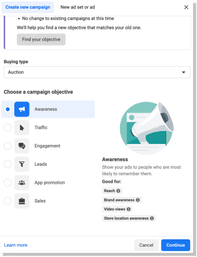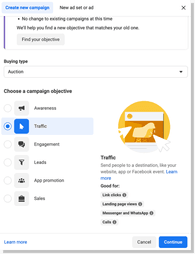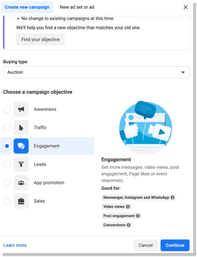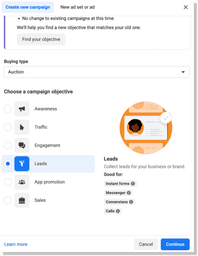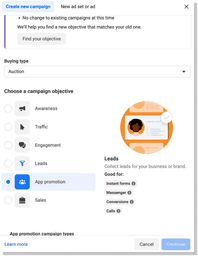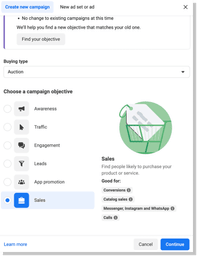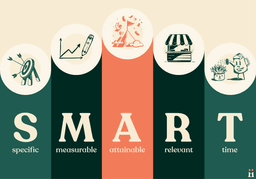
Mastering Meta Ads: Ad Objectives Guide & Best Practices
We understand that starting advertising on Meta can be overwhelming, with so many factors to consider. One crucial aspect is selecting the right ad objectives that align with your business goals.
The Journey So Far
Are you keen to start running Meta Ads (Facebook Ads) but unsure where to begin?
There are so many things to consider when you start advertising on Meta.
Ad objectives (A.K.A. campaign objectives) are the first setting you select when creating a new campaign. Objectives are a way of telling Meta Ads what goal you want to achieve with your advertising, which should align with your overall business goal.
Ad objectives have evolved significantly as new features have been released, others removed, and the platform has grown. Initially, it started with a few objectives; Page Post Engagement, Page Likes, Clicks to Website, Website Conversions, and App Installs.
Over time, more tailored ad objectives for different placements, like Stories, were introduced. As Apps became, more popular new objectives were added to promote this, like App Engagement and In-App Purchases.
Meta has taken all of its learning over the years to simplify things for advertisers and condensed the objectives into six options. Ultimately, it makes it easier for advertisers to select an objective that aligns with specific business goals. You can now choose between Awareness, Traffic, Engagement, Leads, App Promotion, and Sales.
What goal you choose will be on a case-by-case basis. These goals may change depending on how familiar your target audience is with your brand and what stage of their decision-making process they are in. It could also depend on what stage your business is in; for example:
- Are you a start-up and have little brand awareness in the market?
- Are you an established brand with a healthy customer list?
- Is there little product awareness in the market for what you offer, therefore, you need to educate the market about the problem and how there is a new solution.
- Are you playing in a cluttered category where product awareness is already high?
All these factors will play a part when deciding which Meta Ad Objective to choose.
Now let’s get into the meat and potatoes, shall we?
The Six Types Of Ad Objectives in Meta Ads
Awareness 📣
This objective aims to target audiences most likely to recall your ad and reach the maximum number of people. This objective is suitable for goals relating to reach, brand awareness, video views, and store location awareness.
Best for:
- New Business/Start-Up – Want to get the word out about your new brand? Grow your business’s brand awareness and get more eyeballs on your brand.
- New Product Launch – Similar to a new brand strategy, this objective can help you reach as many people as possible within your target market to help build awareness, hype, and intent.
- Event Promotion – Let’s say you have a new pop-up store opening and want an opening event. This objective can help you reach a wider audience and generate interest and excitement for the opening.
Awareness Campaign Objectives are good for reach, brand awareness, video views and store location awareness.
Traffic 🚦
This objective aims to send people to your website, apps, or event. It’s suitable for goals related to link clicks, landing page views, messages, and calls.
Best for:
- Website Traffic – As the ad objectives name suggests, getting more people to visit your website is a good objective.
- Content Promotion – If you want to promote a new blog article you just wrote, this objective can help increase the number of visitors to the particular webpage.
- Event Registration – You want to get a V.I.P. invite list for your pop-up store opening. This objective can get more people to your landing page to sign up.
Traffic Objectives are good for link clicks, landing pages views, messenger and WhatsApp, and calls
Engagement 👍
Discover users inclined to interact with your business online, reach out via messenger or perform desired actions on your ad or Meta page. The optimum use of this objective is for conversion, messaging, video view, and post-engagement goals.
Best for:
- Boosting Post Engagement – If you have a post on your Meta page and want to increase exposure. This objective will help you get more likes, comments, and shares on your posts.
- Grow your organic socials – You want to increase your followers for your Meta page. The engagement objective will help drive more people likely to follow your socials.
- Drive app engagement – If you have a mobile app and want to increase user engagement, you can use the engagement objective to encourage people to interact with your app and leave reviews.
Engagement Objectives are good for Messenger, Instagram, and WhatsApp, Video views, Post Engagement, and Conversions (questionable)
Leads 📞
Get leads for your business via in-platform lead forms, messages, or phone calls. This objective works well for goals related to lead generation, messenger, and calls.
Best for:
- Generating enquiries for your business – Using an in-platform lead form can help get more leads, as users won’t need to navigate to the website. This can be connected to your backend CRM, and once a lead is received in-platform, it can enter your enquiry flow.
- Building Your Customer List – Generate more emails and grow your first-party data. You can even offer a discount to entice more people to sign up.
- Download Content – This is a great way to collect details for interested users if you have downloadable content like a guide or report. Again, you can connect your CRM to this form to automatically send out the content once someone has entered their details.
- Webinar registrations – Reach more users who may be interested in signing up for your webinar and get their information.
Lead Objectives are good for Instant Forms, Messenger, Conversions, and Calls
App Promotion 📱
Find users on a mobile device who will install or take a desired action within your app—mainly used for app installs and app events.
Best for:
- App install – Reaching new users likely to install your app on their devices.
- App events – Reaching users who will perform a desired action within your app. For example, you have an audience who downloaded the app but wants them to use a new feature.
Instant forms, Messenger, Conversions, and Calls
Sales 💰
Discover users who are more inclined to purchase your goods or services. This is best for conversions (purchases) and catalogue sales.
Best for:
- Driving Product Sales – If you want to sell more of your products through Meta, you can use the sales objective to encourage people to purchase directly from your ad or website.
- Promote Limited-Time Offers – If you have a limited-time special on your products or services, you can use the sales objective to create urgency and encourage people to purchase before the offer expires.
- Upsell and Cross-Sell: If you have complementary products or services that you want to promote to your existing customers, you can use the sales objective to encourage them to make additional purchases.
Conversions, Catalog sales, Messenger, Instagram & WhatsApp, and Calls
How to Choose the Right Ad Objective
So now you have a better idea of the different ad objectives. The next part is to choose the right ad objective for your strategy and goals. It may seem like a big decision, but we’ve broken down this process into three steps to help you find the right starting point.
3 steps to choosing your ad objective
Step One – Define Your Campaign Goals and Objectives
Defining your campaign goals is a crucial step in any advertising campaign, and there are a few key questions you’ll need to answer to ensure you’re setting yourself up for success.
- Determine your business objectives – Start by identifying the business goal you hope to accomplish with this campaign. What exactly are you trying to achieve? Do you want to increase brand awareness or sales?
- Define your Key Performance Indicators (KPIs): These will measure the campaign’s success. KPIs can be soft metrics like C.T.R. & C.P.M. to determine ad engagement or performance metrics like Return On Ad Spend (ROAS) or Cost Per Acquisition. Or you could choose a metric that factors your overall revenue using Marketing Efficiency Ratio. We set KPIs across soft, performance and overall business metrics.
- Set SMART goals – Create SMART goals for the overall strategy. You’ll want your goals to be specific, measurable, achievable, relevant, and time-bound. Use the KPIs you set in step two to help measure the success.
Setting SMART goals can help guide you when making optimisation decisions.
Step Two – Choose Your Ad Objective
You want to understand all of the different ad objectives you can utilise. At this point, you should have a good idea. Then you’ll want to match the ad objectives to your specific goals.
Step Three – Review and Optimise
You’ll want to continuously review the success of your campaign and optimise your Meta ads. This is not a ‘set and forget’ strategy. It will require you to monitor performance constantly.
Let’s run through an example to bring all of this together!
Step One – Define Your Campaign Goals and Objectives
Let’s say I run an e-commerce fashion business and want to increase sales by 10% this quarter.
Sales are the most important metric to me, so I want to measure the success of this campaign by using a ROAS goal.
I’ve then calculated the costs vs profit for products to understand what ROAS I need to achieve in the platform to make a return on investment. I will set my ROAS goal at 3.5, and we’ll call this the primary goal. Consider setting secondary goals to include different benchmarks. Other metrics include; click-through rate, cost per 1,00 impressions, add-to-cart rate, and spend.
Overall SMART goal:
- Specific = Increase sales quarter on quarter for Q2 by 10%
- Measurable = 3.5 ROAS in-platform
- Achievable = 10% was set as an attainable goal as the businesses revenue has grown by 7.5% quarter or quarter without additional advertising.
- Relevant = Driving more users to the website and increasing advertising efforts will help increase sales and overall revenue goals.
- Time = Three months in quarter two
Step Two – Choose Your Ad Objective
The main goal in our example is to increase sales. So, the sixth ad objective, ‘Sale’, will be perfect! We can then use the conversion event ‘Purchases’ as a signal for the campaigns to optimise.
Step Three – Review and Optimise
We set a three-month timeline for this example. So at the end of Q2, you’ll want to evaluate the progress and success based on your KPIs.
You don’t want to leave your ads untouched during that period! The ad objective is just the starting point to run a successful campaign. You’ll want to ensure you split test ads, copy, and the conversion event. You may even want to split-test different campaign objectives to see if they result in a different outcome.
Farsiight’s Ad Objective Best Practice
We’ve been doing this for a while at Farsiight and developed our best practices when choosing your ad objective. The first step will be completing the exercise above to determine your starting point and the right ad objective.
Our recommendation for conversion-focused advertisers is to avoid click objectives under the Awareness and Traffic category.
These objectives will focus on putting your ad in front of people more likely to recall, click, or view your landing page. While the soft metrics may look great (low CPCs, high CTRs, low CPMs), your performance metrics will suffer.
These objectives will result in a high bounce rate and generally won’t drive volume for meaningful actions. To make matters worse, they fill your funnel with unqualified traffic, which will decrease efficiency in your retargeting campaigns.
We’ve found that Lead or Sale ad objectives are the best ad objectives. You can use conversions from your website as a signal for the campaign to optimise. Being able to tell Meta Ads the exact website action you want to achieve is incredibly powerful and will get you the best results.
Final Thoughts
The first three objectives we spoke about (Awareness, Traffic, and Engagement) are suitable for general brand awareness. That is a good starting point if you are a brand new business or want more exposure for a new product. The last three objectives, Lead, App Promotion, and Sales, are best for driving more meaningful actions.
Ad objectives will also help at different stages of the funnel or decision-making stage that the user is in. You should use a softer goal for your top-of-funnel campaign (A.K.A., brand new users) to get your ads out there and generate a buzz. Then for middle-of-funnel (A.K.A., users who have been to your website/interacted with your brand), you should focus on your primary goal.
Eventually, you’ll focus your campaign objectives on the last three options, as these will generate the most quality traffic, leads, and purchases. Then you can get deeper into your optimisations and explore different conversion events to optimise towards.
As mentioned, it’s never a ‘set and forget’ strategy. Reviewing your Meta Ads strategy is a task we recommend questioning regularly. If you have any questions feel free to contact our friendly team to discuss your digital marketing strategy!

Malinder Ah-chong
The amount of hats this girl wears is through the roof… literally! We love her creative brain, no one can write performance copy quite like Malinder.
Like what you read?
Learn more about digital, creative and platform strategies below.
